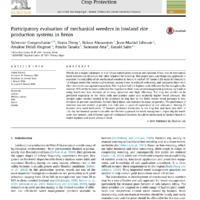Recherche
2 items
Expanding capacity for translating seasonal climate forecasts into actionable information for agriculture and water sectors in West Africa: Lessons learnt and way forward
With climate change and variability posing challenges to sub-Saharan Africa’s development sectors, weather and climate information services are crucial for building climate-resilient development pathways (Hansen et al., 2022). Seasonal forecasts in particular provide prospective information about the upcoming season, with a particular focus on precipitation and temperature (Guido et al., 2020; Hansen et al., 2011). However, a direct and linear translation of the seasonal forecasts to sector-specific information such as water resources and agriculture can lead to inaccurate recommendations. Integrating seasonal forecast data into biophysical models can enable the generation of sector-relevant actionable information that can improve the decision-making (Hansen, 2005; Houngnibo et al 2023). This would contribute to a better understanding of the impacts of climate forecasts in the water and agriculture sectors, among others, thereby facilitating more informed decision-making.
Regional operational meteorological centers, including AGRHYMET Regional Climate Center for West Africa and the Sahel (AGRHYMET CCR-AOS), are regularly producing seasonal climate forecasts to help inform adaptation decision-making at various levels. As a Regional Climate Center, AGRHYMET CCR-AOS coordinates the development of consensus seasonal forecasts through Regional Climate Outlook Forums (RCOF), which bring together experts from National Meteorological and Hydrological Services (NMHSs), basin organizations, and global climate centers. AGRHYMET CCR-AOS has proposed a new approach to translate seasonal forecasts into sector-specific actionable information for agriculture and water sectors through crop and hydrological models. This is referred to as extended seasonal forecasts in agriculture and water sectors (Houngnibo et al 2023).
As part of AICCRA West Africa cluster activities, AGRHYMET has capacitated NMHSs in West Africa and the Sahel on this approach as a first step towards extended and widespread uptake and utilisation in NMHSs in the region. The capacity building event took place in Ouagadougou, Burkina-Faso from August 7th to 11th, 2023. The objective was to enhance the capacity of NMHSs to use new tools that combine seasonal forecasts with impact models in the agriculture and water resources sectors. This Info Note documents the process, key insights and lessons from the regional capacity building for translating seasonal forecasts into actionable information for agriculture and water sectors in West Africa for a better-informed policy and action decision making.
Participatory evaluation of mechanical weeders in lowland rice production systems in Benin
Weeds are a major constraint to rice (Oryza sativa) production in sub-Saharan Africa. Use of mechanical hand weeders could reduce the labor required for weeding. This paper uses a participatory approach to examine the suitability of six mechanical weeders in Benin. A total of 157 farmers (93 male, 64 female) in 14 villages tested the mechanical weeders, ranked them in order of preference, and compared them with their own weed management practices. The ring hoe had the highest rank, followed by the straight-spike weeder; 97& of the farmers preferred the ring hoe to their own weed management practices, by hand or using traditional hoe, because of its easy operation and high efficiency. The ring hoe tended to be preferred especially in the fields with non-ponded water and relatively higher weed pressure. The straight-spike weeder tended to be preferred to ring hoe in the fields where weed pressure is less, whereas in ponded conditions, farmers liked these two weeders in equal proportion. The preference of weeders was not related to gender, rice field size, or years of experience of rice cultivation. Among 23 farmers who used herbicides, 17 farmers preferred herbicides to the ring hoe and have rice field of >0.5 ha. Mechanical weeders can offer an effective approach for weed management, especially for smallscale rice farmers, and different types of mechanical weeders should be introduced to farmers based on water regimes and weed pressure level.

